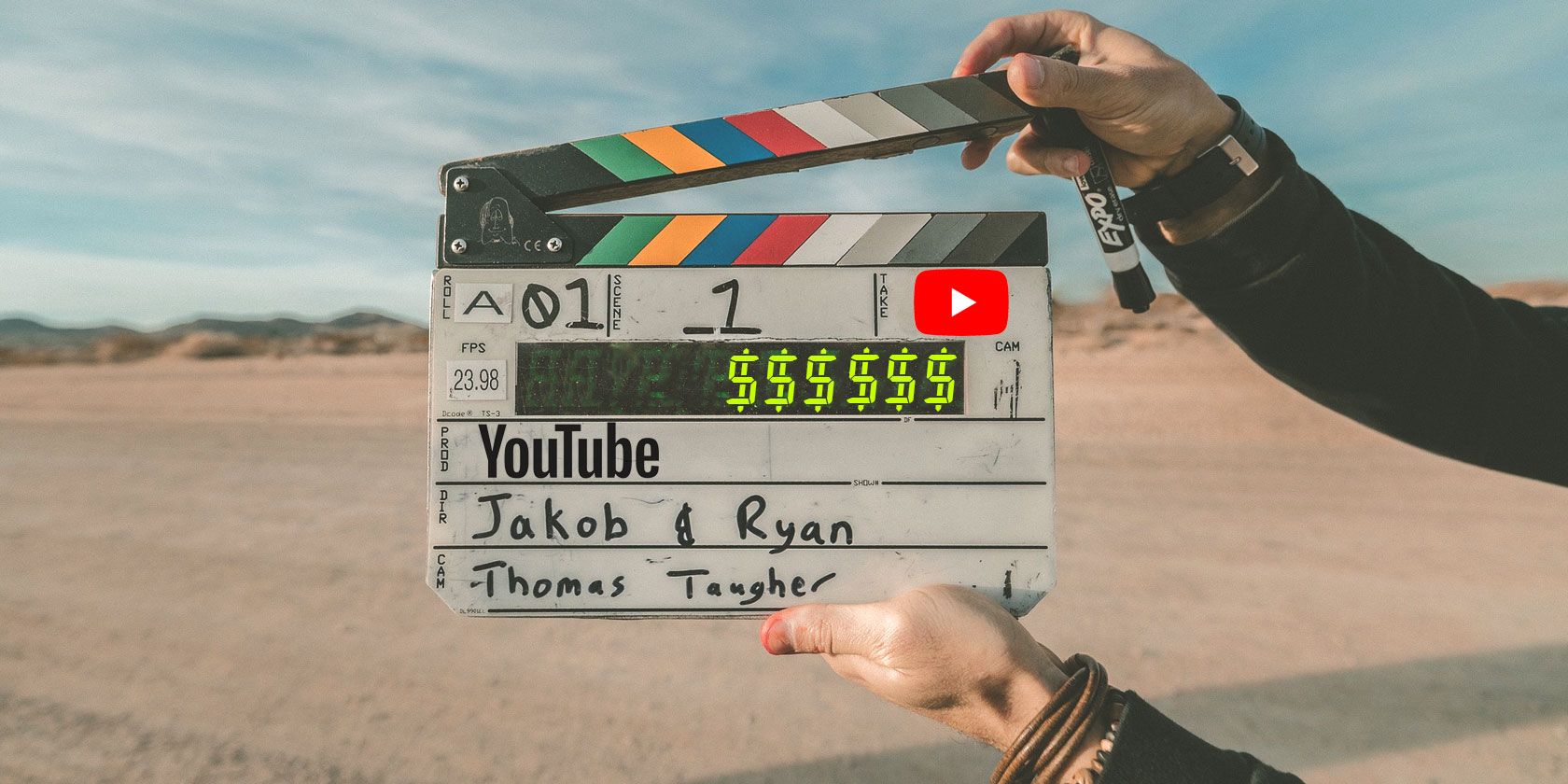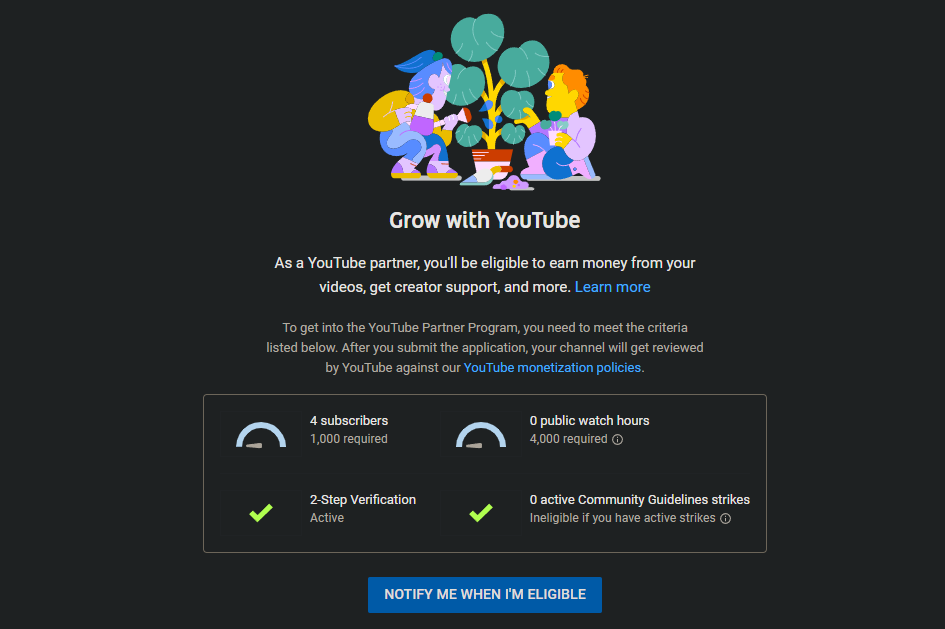While anyone can enjoy uploading videos to YouTube for fun, the time might come when you want to actually earn an income from your video content. If you're thinking about spending serious time on your channel, you've probably wondered how to make money on YouTube.
The truth is that very few people will become rich on YouTube, so it's important to set realistic expectations. However, as a YouTuber, you have several options for monetizing your videos and earning money from your work. Let's take a look at how to make money on YouTube by discussing the most popular methods of monetization.
1. Advertising via the YouTube Partner Program
Like most free services, YouTube is powered by advertising (unless you pay for YouTube Premium). Before you watch most videos, and often in the middle of longer ones, you'll have to watch a short ad. Some of the money from this goes to the channel; the rest goes to YouTube itself.
YouTube has certain guidelines for when your channel is eligible to join the YouTube Partner Program. Joining this is required for monetization (meaning that ads show on your videos). At the time of writing, YouTube requires a channel to have 4,000 watch hours in the prior 12 months, plus 1,000 subscribers, for monetization. See the YouTube Partner Program overview page for more details.
This means you won't be able to make money from ads until you start building a fanbase on YouTube. To check your progress, visit your YouTube Studio page, then click the Monetization tab on the left. You'll see if your channel meets the requirements, and if not, where you've fallen short. Click Notify me when I'm eligible if you want to receive an email when you've achieved them all.
When you meet the requirements, you can proceed to enable monetization on your channel using this page. You'll need to link your AdSense account, choose what types of ads you'd like on your videos, and then go through a review.
Unfortunately, there's no simple formula for how much money you can make through YouTube ads. It depends on how many people watch the full ad, how many viewers use an adblocker, and other factors. In addition, YouTube has experienced a lot of problems in the past with advertisers pulling their ads from the platform. This has led to the site demonetizing videos for a variety of reasons, and often changing the rules around monetization, which makes income from it inconsistent.
Overall, this means that when you're starting out, ad revenue is not guaranteed. To deal with YouTube's monetization issues, many creators utilize additional methods to make money on YouTube.
2. Product Placements
Product placement is an age-old advertising technique that's common in TV shows and movies; it works for making money on YouTube as well. The practice essentially boils down to using specific brands in order to promote them. For example, a movie from Sony Pictures may include a shot of someone playing a PlayStation on a Sony TV.
On your YouTube channel, you may be able to strike a product placement deal with a company that's relevant to the kind of videos you produce. Of course, you'll likely need to build a following before a brand will want to advertise with you, so this isn't something you can do when just starting out.
The product placement doesn't have to be the entire focus of your video—just part of it. Mentioning or using a brand in your video in a natural way is all that's required. The Rhett & Link video embedded above is an example of product placement done well, as the music video stands on its own outside of the Buick promotion.
This is a solid advertising tactic because people can't skip it. Additionally, viewers often feel a connection with their favorite creators. This lends more authenticity to your recommendations, but you have to take care that this doesn't backfire.
If you don't make it clear that you've been paid for the promotion, or don't actually like the product you're reviewing, it could negatively affect your viewers' opinion of you. Thankfully, YouTube includes a checkbox to let all viewers know that a video contains sponsored content. This makes it clear upfront that you were paid for the inclusion.
3. Sponsorships and Sponsored Videos
Sponsored videos are similar to product placement, but with a few key differences. While product placement involves integrating a brand into an existing video, a sponsored video is entirely based on that brand or product.
For instance, if you run a gaming channel, a developer might approach you to make a video about its game. Since you likely wouldn't have played this game otherwise, you'll let your viewers know that the developer paid you to make the video. A good sponsorship agreement would allow you to share your true thoughts about the game so that any praise doesn't come across as phony.
Sponsorships come in less drastic forms, too. Many YouTubers include a short sponsor message at the start or end of their videos. This is essentially a quick advertisement for a brand that's separate from YouTube ads. Sometimes, these include a discount code for viewers to save a bit of money if they sign up for the service.
Like product placement, sponsored videos are a good alternative for making money, but you should be careful with them. If you don't come across as genuine, your audience might find these videos or mentions in poor taste. Thus, you should try to avoid advertising anything you've never actually used, or don't truly endorse.
4. Affiliate Links
You've probably heard of affiliate links, as many websites use affiliate systems to make money. Essentially, affiliate links allow you to create a unique URL to a website. When anyone follows that link and buys a product, you get a small percentage of the sale.
These are pretty easy to set up, and don't require sponsorship deals from brands. If you talk about a certain product in your video, you can include an affiliate link to its Amazon page in the description. Or you could add an affiliate link for services like Audible, where you'll make some money if someone decides to sign up.
Affiliate links are a good passive source of income. After all, if someone is going to buy a product anyway, it doesn't make any difference to them if they buy it through your affiliate link. Like the other methods, it's a good idea to clearly disclose to your audience when you include affiliate links.
Keep in mind that a lot of common affiliates have become pervasive on YouTube. Sponsorships from services like Audible, Squarespace, and VPNs are extremely common, so you may not earn a lot of money by using affiliate links for those services since people see them all the time.
5. Fan Funding and Channel Subscriptions
Many people have turned to fan funding as an alternative way to make money on YouTube. This often involves joining a service like Patreon or SubscribeStar that lets fans donate some money each month to support their favorite channels.
Most creators who use a service like this offer tiers of rewards in exchange for their fans' support. You might list their names at the end of each video, host a video chat with them every month, provide early access to videos, or provide behind-the-scenes clips. It's a great way to connect the biggest fans with their favorite channels, and provides a fairly steady form of revenue that's not reliant on ads.
YouTube now offers its own way to do this through the Channel Membership feature. Once your channel meets certain guidelines, you can allow viewers to sponsor you monthly through YouTube in exchange for a few perks, in much the same way as Twitch subscriptions work. It's up to you whether to pursue sponsorships on or outside of YouTube.
If you livestream on your channel, you can also use the Super Chat feature. This allows viewers to donate money in exchange for highlighting their message for a time during a stream.
Finally, it doesn't hurt to have a donation link set up for a service like PayPal. As long as you aren't begging for money, someone who enjoys your work might use the link to send you a few dollars.
6. Selling Merchandise
Another monetization option is creating merchandise to sell to your fans. Websites like Spreadshop let you create custom designs for T-shirts, wall art, mugs, and more. Many creators offer designs featuring popular catchphrases, jokes, or art from their videos.
Once you've created some cool designs, let viewers know about them at the start of a few videos. In addition to listing the link to your shop in the video description, YouTube's merch shelf feature lets you showcase some products right under your videos for more visibility.
Selling physical products is a good way for your fans to support you while getting some cool swag at the same time. You'll just need enough of a following that people will have an interest in buying your merch.
7. Consider Branching Out to Other Services
This last point is a little different from the above but still worth considering. If you've gotten to the point where you're enjoying success on YouTube and earning some money, it's not a bad idea to diversify your work online a bit. Spending some time on other platforms will open even more revenue streams for you.
For example, if your YouTube channel is known for scripted videos on a topic like cooking tips or video games, you might start using Twitch to stream to your viewers directly and earn money through subscriptions there. If you don't already use services like Instagram to drive traffic to your YouTube channel, try posting clips to catch people's eyes as they scroll through videos on that platform.
Whether you use other services to bring more people to your YouTube channel or bring your followers to another platform for a new type of content, you won't be limited to just YouTube.
Now You Know How to Make Money on YouTube
While you have many YouTube monetization options available, remember that making money from YouTube is not easy. You'll have to produce quality videos for some time in order to build the viewership required for ads, sponsorships, and more.
If you're just starting out, focus on making awesome videos and making your channel one that people want to subscribe to. And hopefully, over time, your audience will come. You can then look deeper into these monetization options once your channel becomes more popular.


